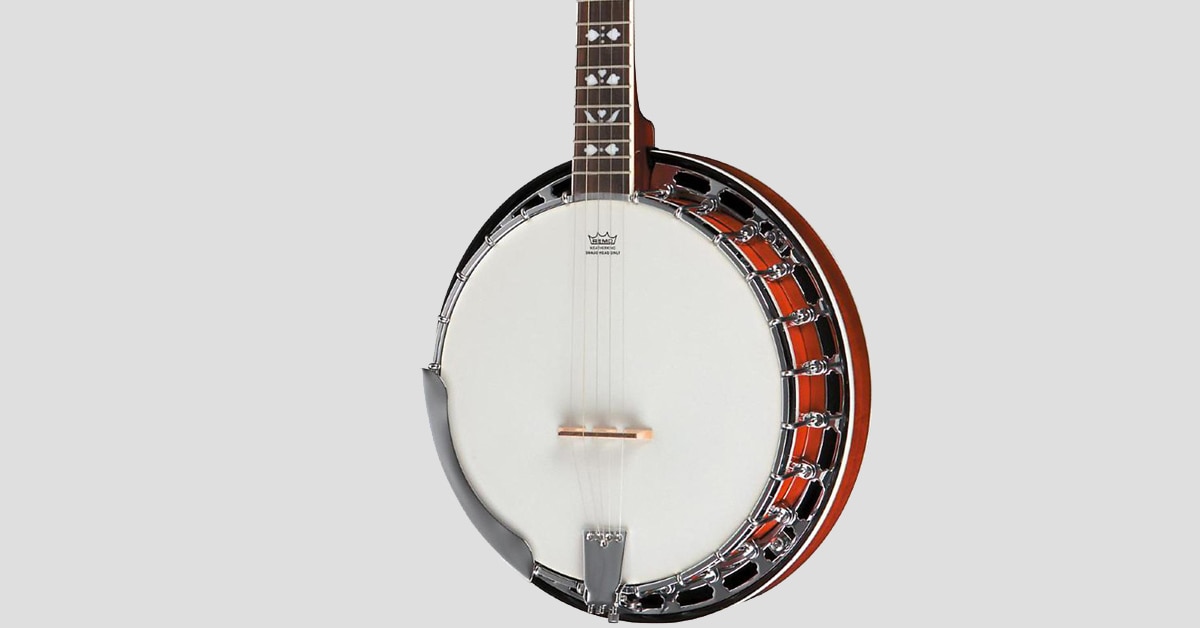There are few things as quintessentially American as the image of a player sitting in a rocking chair on the front porch strumming on a banjo. One of the essential instrumental voices in American bluegrass, country, dixieland jazz, and folk music, the banjo is lots of fun to play, and mastering it can offer a lifetime of satisfaction. Its bright and articulate tone is relatively easy to produce, and the banjo’s percussive rhythms add bounce and drive to many different music styles. In its modern form, a case can be made that the banjo is among the few musical instruments that’s purely American-bred.
Artists such as Béla Fleck have taken the banjo far beyond its musical roots by using it in classical, jazz, and fusion contexts. Modern acts including Mumford and Sons, The Carolina Chocolate Drops, and The Avett Brothers have helped rekindle interest in playing banjo among younger players. Where it was once thought of as a strictly hillbilly instrument, the banjo is enjoying newfound popularity today.
In this buying guide we’ll walk you through the basics of banjo history, various playing techniques, banjo types and their construction, and the resources that will help you get started playing banjo.
Table of Contents
How Much Should I Figure on Paying?
A Brief History of the Banjo
Banjo Playing Techniques
Parts of the Banjo
Banjo Construction Methods and Materials
Assessing a Banjo’s Quality
Modern Banjo Types
Modern 5-String Banjos
Modern 4-String, 6-String, and Hybrid Banjos
Banjo Accessories
Getting Started Playing the Banjo
Summing Up
How Much Should I Figure on Paying?
As with most things, you get what you pay for. You’ll find no-frills, mass-produced student banjos that are made in Asia and priced from around $150 to hand-crafted professional instruments with deluxe appointments and the highest grade materials that carry serious price tags. In between those extremes are dozens of moderately priced banjos, most of which are very playable and tonally satisfying. Even the lowest-priced models are usually quite playable and offer the student with limited funds a worthy introduction to playing the banjo. How much you should pay is a function of your budget, your commitment to mastering the banjo, the type of music you want to play, and your desire for certain features. As a general rule of thumb, buy the best banjo your budget allows to get the best combination of playability, appearance, and sound.
Reading reviews by both experts as well as fellow customers on Musician’s Friend’s website can help narrow your choices.
Check out the huge selection of banjos at Musician’s Friend.
The Banjo—A Brief History
The origins of the banjo as we know it are unclear. It has some resemblance to West African instruments such as the kora with its plucked strings and skin head stretched on a gourd body. But unlike the banjo, the kora has a stick neck and metal loops that function similarly to frets.
The earliest banjo-like instruments to turn up in the Americas also used a gourd for a body, animal skin for a resonator, and a simple stick neck. They had various numbers of strings that usually included one that produced a drone.
By the 17th century early prototypes of the modern banjo starting appearing in the Caribbean. These instruments with their fingerboards and tuning pegs showed the influence of other western stringed instruments.
These earliest versions of the modern banjo were played by slaves, and it wasn’t until the 1830s that a white Virginian minstrel musician, Joel Walker Sweeney, took up the instrument. His banjo had four full-length strings, a shorter fifth drone string, and had a drumhead-like body. The banjo soon developed an audience on both sides of the Atlantic as Sweeney took his minstrel act to England where his banjo became a staple of music-hall instrumentation.
The banjo enjoyed continued popularity beyond the minstrel era largely thanks to Charlie Poole and his trio, the North Carolina Ramblers. As the result of a baseball injury to his hand, Poole adopted a three-finger picking technique that’s become known as classic or finger-style banjo. With their bluesy fiddle and melodic and intricate guitar and banjo parts, the Ramblers and their popular 1920s records became a prototype for modern bluegrass. Influenced by Poole’s technique, fellow North Carolinian Earl Scruggs, the banjo player in Bill Monroe’s groundbreaking Blue Grass Boys, defined the sound of modern bluegrass banjo in the 1940s.
As various banjo playing techniques evolved, new forms of the instrument were developed as we’ll see.
Banjo Playing Techniques
The earliest style of playing banjo, and still an important one, is called the clawhammer technique. The name comes from the clawlike positioning of the hand, and most modern playing styles grew out of it. Clawhammer involves striking the four main strings in a downward motion using the index or middle fingernail. Simultaneously, the shorter fifth drone string is played with the thumb using a lifting motion. Complex melodies can be played with the addition of techniques such as “drop thumb” and “double thumbing”.
While clawhammer is largely aimed at creating driving rhythms, variations of the technique allow the player to sound single-string melodic notes, strum harmonic chords, and produce all sorts of percussive effects on the banjo’s head. A whole range of brushing and picking effects gives the banjo the ability to play a lead instrument role, rather than simply being an accompaniment to other instruments.
Traditional Appalachian banjo involved a style called two finger up-pick. As noted above, banjo player Earl Scruggs refined and popularized a three-finger style that has become the basis for modern bluegrass banjo technique, and is often referred to as “Scruggs style.” Even people uninterested in bluegrass became familiar with the fast, highly arpeggiated style Scruggs developed thanks to his “The Ballad of Jed Clampett,” the theme song for TV’s "The Beverly Hillbillies."
There are a number of other bluegrass playing styles that have been popularized by the banjo players for whom they’re named. Keith style, named for Bill Keith emphasizes melodic figures. Reno style is a three-finger technique with substantial single-string picking that’s named for Don Reno. As with Scruggs style, they’re played using finger picks and all such styles feature rolls—repeated patterns of eighth notes that are played in eight-note patterns while the player’s left hand chords. By varying the rolls throughout a song, the banjo helps to create rhythms that work within the overriding beat to prevent bluegrass from sounding mechanistic.
Parts of the Banjo
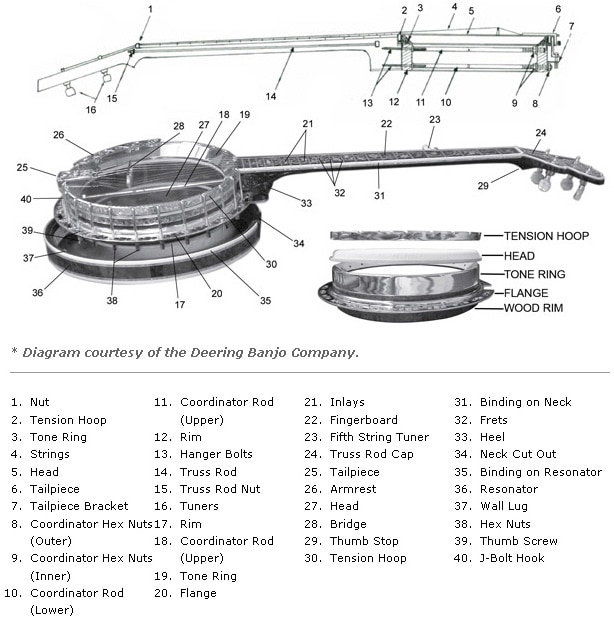
For purposes of illustration, we’ve used a modern five-string banjo.
Banjo Construction Methods and Materials
As you can see from the above diagram, a lot of parts go into building a banjo. We’ll focus on the most significant components here.
Peghead/tuners » Also called the headstock or simply the head, the peghead is where the strings attach to the tuners. Deluxe banjos often have elaborately inlaid decorations on the peghead. The tuners, also called tuning pegs or tuning machines, may have planetary gears or be of the friction-peg type. Some players feel the planetary-gear tuners tend to be more reliable.
Neck/fingerboard » Most commonly made of maple, the neck usually contains a metal truss rod that allows adjustments to intonation and provides rigidity. Better-quality banjos usually have necks made with a single piece of wood while more affordable models may have a laminated neck made of several glued pieces. The fingerboard is glued to the neck and holds the frets that are pressed into place. Fingerboards are usually made of ebony on better-quality instruments, or maple. Higher-end banjos often have inlaid designs in the fretboard that serve as both decoration and position markers.
Nut » Made of bone, hard plastic, or wood, it’s mounted at the base of the peghead and has slots through which the strings are routed down the fretboard. It works in conjunction with the tailpiece to hold the strings in place.
Rim » The hoop that encircles the banjo’s body or “pot,” modern rims are usually made of multiple plies of maple or similar woods. Older banjos may have metal rims. Together with the tone ring, the rim has a significant influence on the volume and quality of the banjo’s sound.
Tone Ring » Positioned above the rim and below the head, it affects the banjo’s tonal range and dynamics.
Head/Bridge » Modern players mostly use mylar heads that resemble drumheads and are impervious to weather and humidity changes. A few players prefer calfskin for its mellower sound. When banjo strings are plucked, the vibration is transmitted through the bridge to the head, which in turn causes the rim and tone ring to vibrate, producing the banjo’s sound. The head’s thickness is another influence on the banjo’s overall tone. The bridge is made of wood and sits on the head. Similarly to violin bridges, the banjo bridge “floats,” held in place by the strings’ tension. The bridge’s height is one further element in creating the banjo’s tone with heavier, denser bridges generally producing a sweeter sound.
Resonator » As noted below, not all banjos are equipped with this metal plate that’s mounted to the back of the banjo and projects sound forward.
Tailpiece » It holds the strings in place and under tension. Ideally the tailpiece should be adjustable to tweak the sound of the instrument, and be vibration-resistant so as avoid adding ringing tones to the banjo’s output.
Assessing a Banjo’s Quality
Even a newbie can make some judgments about a prospective banjo.
Test the action by pressing down on each string along the length of the fingerboard. The strings should make contact with the frets easily without hurting your fingers.
Strum and pluck the strings individually and together. The sound should be pleasant and clear without buzzes or rattles.
Tuners should have their mechanisms enclosed and operate smoothly. On 5-string banjos, a geared 5th-string tuner is preferred by most players as friction-based tuning pegs may not hold their tune as well.
The presence of a tone ring indicates a better-quality instrument.
Modern Banjo Types
Today you’ll find 4-, 5- and 6-string banjos as well as less common forms like the 12-string and fretless banjos. That said, the modern successor to Sweeney’s 5-string banjo is by far the most popular type today.
There are both open-back and resonator-equipped versions of most of the more common banjo types. Resonator banjos have a plate that’s fastened to the back of the body, or the “pot” as it sometimes called. This resonator plate’s purpose is to help project the banjo’s sound forward, giving the instrument more volume and punch in ensemble settings. It is for this reason that most bluegrass musicians, as well as many other banjoists opt for resonator-equipped banjos.
Open-back banjos produce a softer, mellower sound and work well in quieter settings. Due to their less complex construction they weigh less and often cost less than their resonator-equipped counterparts. Open-back 5-string banjos are popular with fans of American old-time music, and are usually played using variations of the clawhammer technique.

The Deering Goodtime Banjo has an open-back design and produces sparkling, sweet tone.
Most banjo bodies today have a circular wood rim that surrounds the body and a tensioned head made of synthetic material that resembles a drumhead. Unlike older banjos with heads made of animal skins or membranes, these modern heads aren’t affected by temperature and humidity.
Today’s banjos usually have metal strings with the fourth string being wrapped in an alloy. Occasionally, nylon strings are used to produce a mellower sound.
Banjo tuners differ from the worm gear-based tuners typically found on guitars. They are usually of the planetary-gear type or are friction-type tuning pegs. One mark of a quality banjo is the smooth operation of its tuners allowing easy initial tuning of the strings and tuning stability when played.
Modern 5-String Banjos
Unlike other stringed instruments such as the guitar, the strings on a banjo don’t go from lowest to highest across the fingerboard. Instead, from low to high they follow this arrangement: fourth, third, second, first, and fifth. The fifth string, which produces a drone and is also called the “thumb string,” is attached to a tuner mounted on the neck at the fifth fret, making it three-quarters the length of the other full-length strings. It’s most often the same gauge as the first string.
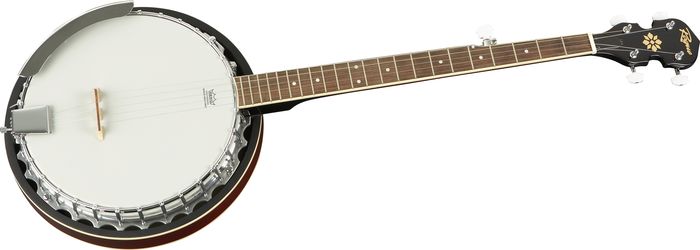
The Rogue B30 is a very affordable 5-string banjo that makes an ideal starter instrument.
Special fifth-string capos are available to alter the tuning of the drone string beyond the one or two semitones allowed by its tuner. There are many tunings used on 5-string banjos with open-G (G-B-G-B-D) being the most common one used in bluegrass. In old-time music, many tuning variations are used including double-C (G-C-G-C-D) and open-D (F#-D-F#-A-D). These tunings frequently are moved up a tone by either tuning the strings to the higher pitch or using a capo.
Modern 4-String, 6-String, and Hybrid Banjos
There are two forms of 4-string banjos: the plectrum and tenor. The plectrum is similar to a 5-string banjo, but lacks the drone string. Primarily played in dixieland bands, it’s strummed with a guitar pick. The tenor has a shorter scale and is popular with traditional Irish music players.
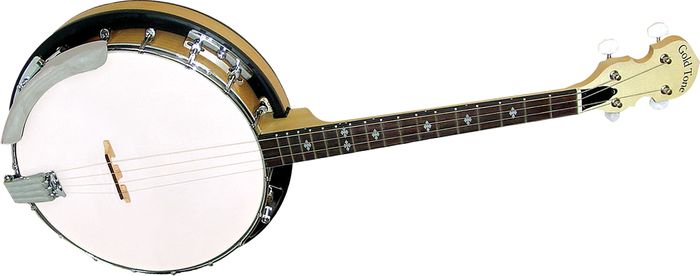
The strong-voiced 4-string Gold Tone Cripple Creek Tenor Banjo is equipped with a resonator and is a popular choice among Celtic banjo players.
6-string banjos in various forms have been around since the mid-19th century. A popular hybrid variation of the 6-string is the guitar-tuned banjo. Because it is tuned like a guitar, it makes a great crossover instrument for guitarists while retaining the sound of a standard banjo.
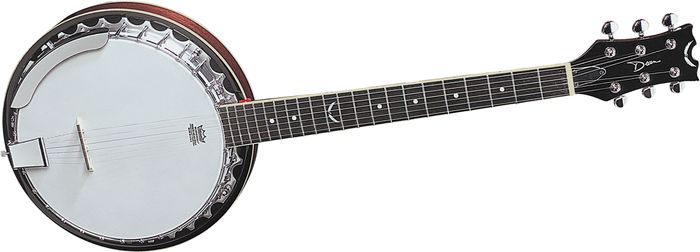
The Dean Backwoods 6 is a 6-string banjo with guitar tuning, making it a great crossover instrument for guitarists.
There are handful of hybrid banjos that marry the characteristics of an electric guitar with those of a traditional banjo. Their bodies, which may resemble an electric guitar profile, are made of a solid piece of wood that contains a cutout area for the head and has electronic pickups to sense the heads vibrations. These electric banjos can be played using a standard guitar amplifier, and easily hold their sonic ground in amplified band contexts without feedback issues.
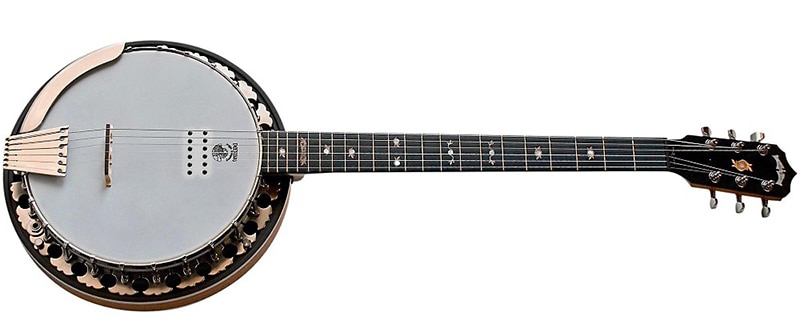
With its humbucker pickup, the Deering Boston 6-String Acoustic-Electric Banjo gets loud in amplified settings while retaining that crisp Deering tone.
The banjolele is a hybrid instrument that offers the portability and easy learning curve of a ukulele with a sound that resembles a small banjo. With its 4 strings, shorter neck, and smaller diameter head, banjoleles are easy to play and integrate well in quieter acoustic ensembles.
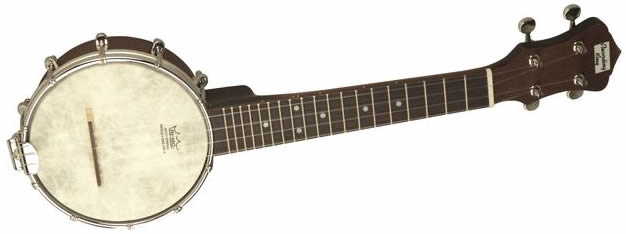
The Recording King U25 Banjolele merges the size and playing ease of a ukulele with banjo-like sound.
Shop Musician’s Friend’s selection of 4-string banjos, 6-string banjos, and banjoleles
Banjo Accessories
Well-chosen accessories for the banjo will enhance your playing experience and help to protect your investment. These include:
Banjo straps: This is a necessity if you plan to play standing up. There are many choices of materials and looks to suit your personal taste.
Banjo capo: This device clamps on the fingerboard allowing you to raise the overall pitch of the banjo so you can play songs in keys that are higher than those they were written in. This can be especially useful for singers whose vocal range is higher than the song’s usual key.
Banjo cases and gig bags: They protect your banjo from scrapes and scratches. A case or gig bag is pretty much essential if you plan to take your banjo on the road or to gigs.
Banjo strings: Sooner or later you’ll need to change your banjo’s strings. A fresh set can revive the tone of a banjo that seems to have lost its luster. Strings are made using various materials, each with their own tonal characteristics. Experimenting with several types can help you find a tone that’s more pleasing and brings out the type of sound you’re seeking.
Tuner: A good-quality tuner will make the process of tuning up your banjo much easier. Some models have a specific mode for tuning banjos that makes the process even simpler.
Getting Started Learning to Play the Banjo
While having a friend or professional teacher show you the ropes is invaluable, nowadays there are a lot of resources available to get you started playing the banjo on your own. These include:
Banjo Instructional Books, Tutorials, DVDs, and CDs
You’ll find a huge range of resources to match your banjo expertise, whether you’re an absolute beginner, intermediate student, or seasoned player looking to improve your skills. Many banjo how-to’s and tutorials include DVDs and CDs with all kinds of audio and video examples of the techniques being taught. Some also include access to online resources where you can post questions and chat with other banjo students, teachers, and enthusiasts. Many of these banjo instructional books and media are focused on specific music styles such as bluegrass, country, or folk.
Banjo Songbooks, Chord Guides, and Easy Tab Arrangements
With dozens of titles to choose from, you’ll find all the songs and music styles you love represented. Many offer simple arrangements of popular songs that are easy for beginners to learn. There are also numerous banjo songbooks and learning tools written by the pros you admire, offering their tips and tricks for creating great music on the banjo.
Summing Up
You should now have some good basic information about the kinds of banjos out there as well as the things to look for in shopping for a banjo. There is no simple formula in arriving at the best instrument for your needs and budget. Your fingers and ears should be the ultimate judge.
One basic suggestion is to shop for the best instrument that falls within your budget. A poorly made banjo that’s hard to play and tune is likely to discourage even the most determined student.
Reading professional and online reviews of various banjo models can be helpful in pinpointing the right instrument. You’ll also find hundreds of user reviews from fellow musicians and banjo students alike as you peruse our collection of banjos.
We want you to be pleased with your banjo purchase, and offer a 100% satisfaction guarantee and generous return policy so you can order your new banjo with confidence.





































































































































